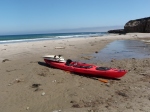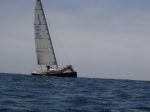Greetings from San Diego. After 48 days of paddling, we have reached Scripps Institute of Oceanography, the goal of our trip! Since our last post, we have paddled the final 100 miles from Santa Monica to La Jolla.
In Venice Beach we met the friendly folks at ASR. The company designs artificial reefs, submerged geotextile bags that dissipate wave energy to prevent beach erosion. The reefs can also create habitat for marine life and, if conditions are right, create good surf breaks. Needless to say Lane, Michael, and I were quick to jump on the opportunity to tour ASR. Thank you Matt Inkeles for showing us around Venice Beach office and giving us a taste of what ASR aims to do. Starting at Santa Barbara, we have kayaked past countless seawalls and jetties built to keep sand on the beach. There is hardly a mile of unobstructed coastline in Southern California. Seeing a creative way to go about dealing with California’s erosion problem was inspiring.
Before leaving Venice Beach, we stocked up with three bottles of ginseng extract from Windward Farms market. We weren’t sure when we would need the ginseng boost, but with 100 miles to paddle in 7 days, the moment would was sure to come.
We made quick time through Orange County. At the Huntington Beach Pier we paddled right up to the US Open of Surfing to see the legendary Kelly Slater and Rob Machado trade waves 100 yards off our kayaks. Of the tens of thousands of spectators, we had the most unique seats in the house. Both Kelly Slater and Rob Machado were usurped by young Aussie upstart Ace Buchan in the 30 minute heat. After the final horn, we paddled away chuckling at our good fortune. Up in Monterey, we kayaked past the tents left behind from the US Open of Golf at Pebble Beach, and now we were paddling past surfing’s equivalent of the same event.
Off Laguna Beach Dana Point, Michael and I were awestruck to see a pod of 100 + dolphins whisking towards us. The dolphins swam within feet of the kayak while splitting up into groups and darting after fish. Unlike the larger bottlenose dolphins we had nearly exclusively seen up to this point, we believe these were Pacific White sided dolphins due to their two-tone fins and majestic white side marks. It was a humbling sight indeed.
That night we stayed with the Stanford Water Polo team in San Juan Capistrano. Thank you to the Laforge family for the food and floor space. We’ll never forget 205 pound defender Andrew Laforge pulling out a gallon size bag full of cooked beef chunks to offer us a snack. Maybe next time dude.
The next day we paddled the final leg of the OC into San Onofre. Although we didn’t see any real housewives, the coast from Laguna Beach down to San Clemente is a gorgeous stretch, from the spectacular mansions on private beaches to perky Nuclear Power reactors.
The Camp Pendleton Marine Base separates San Diego and Orange County. We had been nervous about paddling around the base for weeks, but camp officials assured us we would be safe as long as we kept well offshore. If the deafening blasts we heard at the base’s boundary weren’t enough to keep us away, we received warning on the Local Notice to Mariners that the Marines would be testing Expeditionary Fighting Vehicles (EFVs) during the period we planned to paddle around Pendleton. The Coast Guard advised avoiding the area, as the EFVs are difficult to steer, reach high speeds, and kick up some large wakes. Without deliberation we decided the skip the Camp Pendleton section of the coast.
For justification of our decision, check out this video of an EFV:
That night we stayed with my Uncle George and Aunt Heidi before launching at Oceanside Harbor the next morning. Thanks for the berry pancakes, warm showers, and real beds. We were feeling a little too pampered by morning, so we decided to make it a long day and paddle the 20 miles to my family’s place in Del Mar.
Paddling into Del Mar was a beautiful end to the trip. It was a classic warm Southern California evening, with the sun setting over the glassy sea. It seemed as though all the surfers forgot what they were doing for a moment to watch the sun sink over the horizon. Tingling with excitement (or possibly ginseng extract), we paddled rhythmically to familiar shores.
We struck up conversation with a friendly paddle boarder just off the Del Mar Rivermouth.
“Gorgeous sunset eh”
“Yea, you’ve got the best seat in the house” replied Lane.
“Where’d you guys launch from?”
“Monterey”
“Oh… I came from right there” pointing in to shore “I hope you guys took a few breaks”
My brothers paddled out on their surfboards to greet us, with friendly splash battle ensuing. The swell was up, and Lane and I had to time our landing correctly, mostly to save ourselves the embarrassment of flipping our kayaks in front of my family. Pulling onto the beach, hugs were exchanged and my dad’s fish tacos were passed around. With only one more day of kayaking to go, we feasted and rested, knowing that we were own the brink of finishing something special.
On Wednesday the 11th we launched from Del Mar and paddled the final 7 miles into the Scripps Institute of Oceanography in La Jolla. The warm water got us thinking back to the frigid seas of Monterey nearly two months earlier. We recalled our former selves like seasoned war veterans. We really had no idea what we were getting ourselves into. But here we were down in idyllic La Jolla, with nearly the entire lower half of California under our belts.
At 2:15 Pm we landed in at the Scripps Institute of Oceanography to a chorus of hoots and cheers (mostly our own) and generous Mexican feast. In a funny coincidence Laura, one of our friends at Stanford who interns at Scripps, was tasked with organizing a little reception for us. Thank you to Laura, Benjamin, Rivah, and professor Ron Burton for the warm welcoming and warm tamales. We enjoyed sharing stories from the coast and hearing about the incredible work at SIO.
Awash with nostalgia, Lane Michael and I loaded the kayaks on top of the Suburban, and did something he hadn’t done in nearly two months – headed north. As the last notes of the trip’s music still ring, Lane, Michael, and I would like to thank all the people that helped us dream up and carry out this incredible trip.
The Montgomery Family
The Taylor Family
The Hartman Family
The Bill Lane Center for the American West
The Stanford School of Earth Sciences
Almond Surfboards
Mysterioso Fleece
Signing off,
Ian, Lane, and Michael
PS. If this blog put anyone in the mood to buy two well-loved kayaks, please call Ian Montgomery at 310-600-0431.














































































































